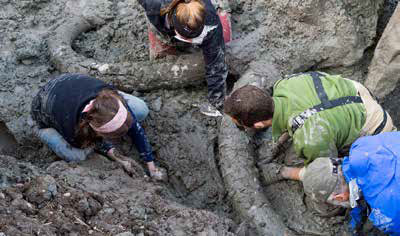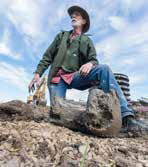
The skeletal remains of a woolly mammoth, which died between 11,000 and 15,000 years ago, were discovered in early October by a soy bean farmer near Chelsea, Michigan, about 10 miles southwest of Ann Arbor. At first, James Bristle, who was installing a drain pipe in one of his farm fields, thought it might be an old fence post. Instead, it turned out to be about 20 percent of a woolly mammoth, including the skull, two tusks, ribs, and vertebrae.
Bristle contacted U-M, which resulted in Professor Dan Fisher of U-M’s Museum of Paleontology leading a dig with a team of colleagues and two excavators. “We get one or two calls like this a year, but most of them are mastodons,” Fisher said. Over the years, the remains of about 300 mastodons (another prehistoric creature) and 30 mammoths have been recovered in Michigan.

“It’s too early to tell how it died, but the skeleton showed signs of butchering,” said Fisher, which would show evidence at the time of “human activity” in this region. Wanting to share the discovery, Bristle donated the bones to U-M for researchers to study and display. Fisher is already working on plans to display the bones at the U-M Museum of Natural History.
One possibility for display might be to combine the partial skeleton, which will be known as the Bristle Mammoth, with bones from other Michigan mammoths to form a complete mammoth skeleton for display at the museum. Fiberglass casts of the bones would likely be used in the mounted specimen.





